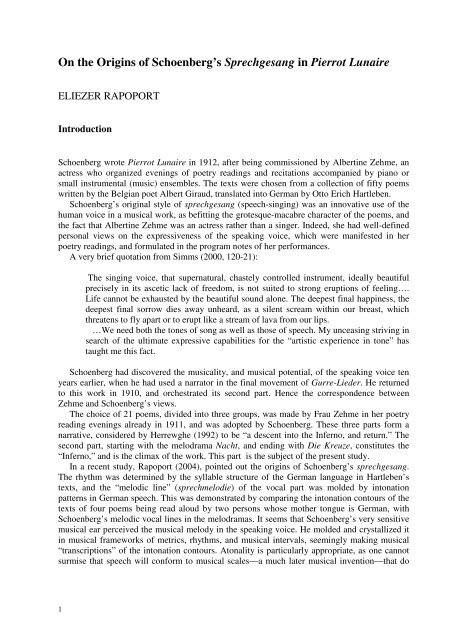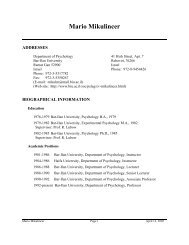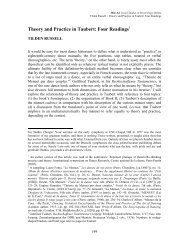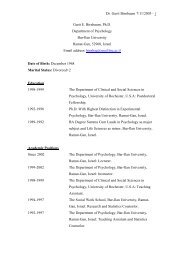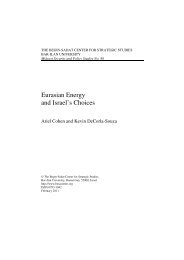On the Origins of Schoenberg's Sprechgesang in Pierrot Lunaire
On the Origins of Schoenberg's Sprechgesang in Pierrot Lunaire
On the Origins of Schoenberg's Sprechgesang in Pierrot Lunaire
You also want an ePaper? Increase the reach of your titles
YUMPU automatically turns print PDFs into web optimized ePapers that Google loves.
<strong>On</strong> <strong>the</strong> <strong>Orig<strong>in</strong>s</strong> <strong>of</strong> Schoenberg’s <strong>Sprechgesang</strong> <strong>in</strong> <strong>Pierrot</strong> <strong>Lunaire</strong><br />
ELIEZER RAPOPORT<br />
Introduction<br />
Schoenberg wrote <strong>Pierrot</strong> <strong>Lunaire</strong> <strong>in</strong> 1912, after be<strong>in</strong>g commissioned by Albert<strong>in</strong>e Zehme, an<br />
actress who organized even<strong>in</strong>gs <strong>of</strong> poetry read<strong>in</strong>gs and recitations accompanied by piano or<br />
small <strong>in</strong>strumental (music) ensembles. The texts were chosen from a collection <strong>of</strong> fifty poems<br />
written by <strong>the</strong> Belgian poet Albert Giraud, translated <strong>in</strong>to German by Otto Erich Hartleben.<br />
Schoenberg’s orig<strong>in</strong>al style <strong>of</strong> sprechgesang (speech-s<strong>in</strong>g<strong>in</strong>g) was an <strong>in</strong>novative use <strong>of</strong> <strong>the</strong><br />
human voice <strong>in</strong> a musical work, as befitt<strong>in</strong>g <strong>the</strong> grotesque-macabre character <strong>of</strong> <strong>the</strong> poems, and<br />
<strong>the</strong> fact that Albert<strong>in</strong>e Zehme was an actress ra<strong>the</strong>r than a s<strong>in</strong>ger. Indeed, she had well-def<strong>in</strong>ed<br />
personal views on <strong>the</strong> expressiveness <strong>of</strong> <strong>the</strong> speak<strong>in</strong>g voice, which were manifested <strong>in</strong> her<br />
poetry read<strong>in</strong>gs, and formulated <strong>in</strong> <strong>the</strong> program notes <strong>of</strong> her performances.<br />
A very brief quotation from Simms (2000, 120-21):<br />
The s<strong>in</strong>g<strong>in</strong>g voice, that supernatural, chastely controlled <strong>in</strong>strument, ideally beautiful<br />
precisely <strong>in</strong> its ascetic lack <strong>of</strong> freedom, is not suited to strong eruptions <strong>of</strong> feel<strong>in</strong>g….<br />
Life cannot be exhausted by <strong>the</strong> beautiful sound alone. The deepest f<strong>in</strong>al happ<strong>in</strong>ess, <strong>the</strong><br />
deepest f<strong>in</strong>al sorrow dies away unheard, as a silent scream with<strong>in</strong> our breast, which<br />
threatens to fly apart or to erupt like a stream <strong>of</strong> lava from our lips.<br />
…We need both <strong>the</strong> tones <strong>of</strong> song as well as those <strong>of</strong> speech. My unceas<strong>in</strong>g striv<strong>in</strong>g <strong>in</strong><br />
search <strong>of</strong> <strong>the</strong> ultimate expressive capabilities for <strong>the</strong> “artistic experience <strong>in</strong> tone” has<br />
taught me this fact.<br />
Schoenberg had discovered <strong>the</strong> musicality, and musical potential, <strong>of</strong> <strong>the</strong> speak<strong>in</strong>g voice ten<br />
years earlier, when he had used a narrator <strong>in</strong> <strong>the</strong> f<strong>in</strong>al movement <strong>of</strong> Gurre-Lieder. He returned<br />
to this work <strong>in</strong> 1910, and orchestrated its second part. Hence <strong>the</strong> correspondence between<br />
Zehme and Schoenberg’s views.<br />
The choice <strong>of</strong> 21 poems, divided <strong>in</strong>to three groups, was made by Frau Zehme <strong>in</strong> her poetry<br />
read<strong>in</strong>g even<strong>in</strong>gs already <strong>in</strong> 1911, and was adopted by Schoenberg. These three parts form a<br />
narrative, considered by Herrewghe (1992) to be “a descent <strong>in</strong>to <strong>the</strong> Inferno, and return.” The<br />
second part, start<strong>in</strong>g with <strong>the</strong> melodrama Nacht, and end<strong>in</strong>g with Die Kreuze, constitutes <strong>the</strong><br />
“Inferno,” and is <strong>the</strong> climax <strong>of</strong> <strong>the</strong> work. This part is <strong>the</strong> subject <strong>of</strong> <strong>the</strong> present study.<br />
In a recent study, Rapoport (2004), po<strong>in</strong>ted out <strong>the</strong> orig<strong>in</strong>s <strong>of</strong> Schoenberg’s sprechgesang.<br />
The rhythm was determ<strong>in</strong>ed by <strong>the</strong> syllable structure <strong>of</strong> <strong>the</strong> German language <strong>in</strong> Hartleben’s<br />
texts, and <strong>the</strong> “melodic l<strong>in</strong>e” (sprechmelodie) <strong>of</strong> <strong>the</strong> vocal part was molded by <strong>in</strong>tonation<br />
patterns <strong>in</strong> German speech. This was demonstrated by compar<strong>in</strong>g <strong>the</strong> <strong>in</strong>tonation contours <strong>of</strong> <strong>the</strong><br />
texts <strong>of</strong> four poems be<strong>in</strong>g read aloud by two persons whose mo<strong>the</strong>r tongue is German, with<br />
Schoenberg’s melodic vocal l<strong>in</strong>es <strong>in</strong> <strong>the</strong> melodramas. It seems that Schoenberg’s very sensitive<br />
musical ear perceived <strong>the</strong> musical melody <strong>in</strong> <strong>the</strong> speak<strong>in</strong>g voice. He molded and crystallized it<br />
<strong>in</strong> musical frameworks <strong>of</strong> metrics, rhythms, and musical <strong>in</strong>tervals, seem<strong>in</strong>gly mak<strong>in</strong>g musical<br />
“transcriptions” <strong>of</strong> <strong>the</strong> <strong>in</strong>tonation contours. Atonality is particularly appropriate, as one cannot<br />
surmise that speech will conform to musical scales—a much later musical <strong>in</strong>vention—that do
not appear <strong>in</strong> natural sounds. Thus, <strong>in</strong> <strong>Pierrot</strong> <strong>Lunaire</strong>, Schoenberg’s atonality is not posttonality,<br />
but ra<strong>the</strong>r primordial pre-tonal music.<br />
The artist uses his raw materials and arranges <strong>the</strong>m <strong>in</strong> stylistic frameworks, emphasiz<strong>in</strong>g<br />
those aspects that he wishes to emphasize, and, <strong>in</strong> twentieth-century music, freely, even with<br />
deliberate exaggeration and distortion. Never<strong>the</strong>less, <strong>in</strong> <strong>Pierrot</strong> <strong>Lunaire</strong>, it turns out that<br />
Schoenberg rema<strong>in</strong>ed quite close to <strong>the</strong> orig<strong>in</strong>s given above.<br />
The purpose <strong>of</strong> <strong>the</strong> present work is a deeper <strong>in</strong>vestigation <strong>of</strong> <strong>the</strong> relationship between text,<br />
speech <strong>in</strong>tonation, and Schoenberg’s sprechmelodies, and <strong>the</strong> light <strong>the</strong>y shed on his<br />
compositional processes. Some <strong>of</strong> <strong>the</strong> different musical transformations and variations that<br />
Schoenberg utilized are demonstrated. We concentrate on <strong>the</strong> seven melodramas <strong>of</strong> <strong>the</strong> second<br />
part <strong>of</strong> <strong>Pierrot</strong> <strong>Lunaire</strong>, <strong>of</strong> which three—No. 8 Nacht, No. 12 Galgenlied, and No. 14 Die<br />
Kreuze—were discussed <strong>in</strong> my previous study (Rapoport 2004). These poems, toge<strong>the</strong>r with<br />
No. 1 Mondestrunken, were chosen previously as <strong>the</strong>y represent four different facets and four<br />
different moods and poetic atmospheres. The addition <strong>of</strong> No. 9 Gebet an <strong>Pierrot</strong>, No. 10 Raub,<br />
No. 11 Rote Messe, and No.13 Enhauptung, <strong>in</strong> <strong>the</strong> present study, is aimed at complet<strong>in</strong>g <strong>the</strong><br />
study <strong>of</strong> <strong>the</strong> set <strong>of</strong> poems compris<strong>in</strong>g <strong>the</strong> second part—<strong>the</strong> climax <strong>of</strong> <strong>the</strong> work.<br />
Methods and Results <strong>of</strong> <strong>the</strong> Present Study<br />
The source material <strong>of</strong> <strong>the</strong> present study is taken from record<strong>in</strong>gs, made <strong>in</strong> 2000 by <strong>the</strong> author,<br />
<strong>of</strong> read<strong>in</strong>gs <strong>of</strong> texts from <strong>Pierrot</strong> <strong>Lunaire</strong> by Dr. Lutz Striem (LSt) already used <strong>in</strong> <strong>the</strong> author’s<br />
previous study (Rapoport 2004). Dr. Striem was born <strong>in</strong> 1920 and educated <strong>in</strong> Berl<strong>in</strong>. In <strong>the</strong><br />
author’s view, he represents <strong>the</strong> closest possible German cultural environment and speech<br />
<strong>in</strong>tonation to Schoenberg’s period. LSt was not previously acqua<strong>in</strong>ted with <strong>the</strong> texts. He read<br />
each text twice. The first read<strong>in</strong>g represents <strong>the</strong> reader’s first impression and spontaneous<br />
reaction to <strong>the</strong> text, and, <strong>in</strong> most cases, was used for <strong>the</strong> analysis <strong>in</strong> <strong>the</strong> previous study.<br />
However, significant changes were sometimes observed on <strong>the</strong> second (rehearsed) read<strong>in</strong>g as<br />
<strong>the</strong> reader got acqua<strong>in</strong>ted with, and ga<strong>in</strong>ed a deeper comprehension <strong>of</strong> <strong>the</strong> text. The FFT<br />
spectrograms <strong>of</strong> LSt read<strong>in</strong>gs were used to create transcriptions to <strong>the</strong> musical notes, and were<br />
raised by an octave—to be compared to Schoenberg’s sprechmelodies. As <strong>in</strong> <strong>the</strong> previous<br />
study, <strong>the</strong> transcriptions were made by measur<strong>in</strong>g <strong>the</strong> sound frequency at <strong>the</strong> midpo<strong>in</strong>t between<br />
<strong>the</strong> tone onset and its term<strong>in</strong>ation, assign<strong>in</strong>g to it <strong>the</strong> note closest <strong>in</strong> frequency taken from <strong>the</strong><br />
Tables. To <strong>in</strong>crease precision, <strong>the</strong> frequencies <strong>of</strong> several harmonic partials were measured. <strong>On</strong>e<br />
should be aware that <strong>the</strong> transcriptions do not represent perceived tones (Rapoport 2004).<br />
Record<strong>in</strong>gs <strong>of</strong> read<strong>in</strong>gs by a young lady, also <strong>of</strong> German orig<strong>in</strong> (Avia Schoenleben, AS, from<br />
Heidelberg), represent<strong>in</strong>g <strong>the</strong> German <strong>in</strong>tonation <strong>of</strong> <strong>the</strong> younger generation, were used <strong>in</strong> <strong>the</strong><br />
previous study, lead<strong>in</strong>g to very similar results.<br />
Comparison between Speech Intonation Contours and Schoenberg’s<br />
Sprechmelodies<br />
In Mahler’s words (cf. Bauer-Lechner 1923):<br />
…with me <strong>the</strong> melody always grows from <strong>the</strong> words. The words, so to speak, generate<br />
<strong>the</strong> melody.… this is <strong>the</strong> only way to achieve <strong>in</strong>dissoluble unity <strong>of</strong> word and<br />
note.…organic fusion <strong>of</strong> both elements.
More specifically, Schoenberg’s sprechgesang was <strong>in</strong>deed shown to have developed from <strong>the</strong><br />
text: <strong>the</strong> syllable structure <strong>of</strong> <strong>the</strong> German language generated <strong>the</strong> rhythm, and <strong>the</strong> German<br />
speech <strong>in</strong>tonation generated <strong>the</strong> melodic contour (Rapoport 2004). In <strong>the</strong> comparison and<br />
analysis carried out here (and <strong>in</strong> Rapoport 2004), Schoenberg’s sprechmelodie is divided <strong>in</strong>to<br />
melodic segments, compris<strong>in</strong>g a word or a group <strong>of</strong> words. The contours <strong>of</strong> <strong>the</strong>se segments are<br />
compared with <strong>the</strong> correspond<strong>in</strong>g segment contours <strong>in</strong> <strong>the</strong> transcriptions <strong>of</strong> LSt <strong>in</strong>tonation. <strong>On</strong>ly<br />
<strong>the</strong> shapes <strong>of</strong> <strong>the</strong> contours are considered, and not <strong>the</strong> specific musical notes or <strong>in</strong>tervals.<br />
Various contour shapes were classified: <strong>in</strong>creas<strong>in</strong>g, (or decreas<strong>in</strong>g) melodic progression,<br />
upward (or downward) jump, arch—convex melodic segment, or <strong>in</strong>tonation contour (see<br />
Rapoport 2004, and <strong>the</strong> special notation developed <strong>the</strong>re<strong>in</strong>).<br />
Consider<strong>in</strong>g Schoenberg’s melodic segment contours as orig<strong>in</strong>at<strong>in</strong>g from <strong>the</strong> correspond<strong>in</strong>g<br />
<strong>in</strong>tonation patterns <strong>in</strong> German speech (such as LSt), one observes <strong>the</strong>ir <strong>in</strong>terrelations as be<strong>in</strong>g <strong>of</strong><br />
several types, ei<strong>the</strong>r simple similarity, or derived from <strong>the</strong> correspond<strong>in</strong>g <strong>in</strong>tonation pattern<br />
(contour) by one <strong>of</strong> <strong>the</strong> follow<strong>in</strong>g operations:<br />
1. Inversion—mean<strong>in</strong>g only <strong>in</strong>version <strong>of</strong> <strong>the</strong> contour type: <strong>in</strong>creas<strong>in</strong>g shape <strong>in</strong>verted to<br />
decreas<strong>in</strong>g shape, upward jump <strong>in</strong>verted downwards, etc.<br />
2. Octave transposition (Stuckenschmidt 1978).<br />
3. Emphasis on last syllable—jump (pitch rise) on last, unstressed, syllable.<br />
In German, <strong>the</strong> stress is usually on <strong>the</strong> first syllable <strong>of</strong> <strong>the</strong> word. This stress is characterized<br />
by its long duration and, usually, pitch <strong>in</strong>crease. The word emphasis is used to denote pitch<br />
<strong>in</strong>crease or pitch jump. It was observed <strong>in</strong> <strong>the</strong> previous study that, <strong>in</strong> special cases and special<br />
words, <strong>in</strong> addition to <strong>the</strong> stress be<strong>in</strong>g on <strong>the</strong> first syllable, <strong>the</strong> second (usually unstressed<br />
syllable) receives an extra emphasis with a pitch jump. This was encountered <strong>in</strong> speech<br />
<strong>in</strong>tonation (LSt and AS), and reproduced by Schoenberg. Examples: “Die duerre Dir-ne mit<br />
langem Hal-se, In se<strong>in</strong>em Hir-ne, Steckt vie e<strong>in</strong> Na-gel” (Galgenlied), and “Heil’ge Kreu-ze”<br />
(Die Kreuze). Underl<strong>in</strong>ed syllables denote <strong>the</strong> emphasized last syllables. Schoenberg uses this<br />
device quite <strong>of</strong>ten, even without a counterpart <strong>in</strong> speech <strong>in</strong>tonation.<br />
No. 9 Gebet an <strong>Pierrot</strong><br />
This melodrama was <strong>the</strong> first <strong>of</strong> <strong>the</strong> cycle that was set to music by Schoenberg. A close look<br />
may yield <strong>in</strong>sight <strong>in</strong>to Schoenberg’s music composition processes and artistic creativity.<br />
Examples 1-3 present comparison between transcriptions <strong>of</strong> <strong>in</strong>tonation contours <strong>in</strong> LSt read<strong>in</strong>gs<br />
and Schoenberg’s sprechmelodies. The first phrase, open<strong>in</strong>g <strong>the</strong> melodrama (l<strong>in</strong>es 1, 2 <strong>in</strong> <strong>the</strong><br />
text), is presented <strong>in</strong> Example 1, and <strong>the</strong> second phrase (text l<strong>in</strong>es 3, 4) is presented <strong>in</strong> Example<br />
2.<br />
Comparison <strong>of</strong> <strong>the</strong> correspond<strong>in</strong>g parts <strong>in</strong> Examples 1-3 demonstrates <strong>the</strong> resemblance, down to<br />
<strong>the</strong> f<strong>in</strong>est details, <strong>of</strong> Schoenberg’s score to German speech <strong>in</strong>tonation, and clearly <strong>in</strong>dicates its<br />
orig<strong>in</strong>s <strong>in</strong> German <strong>in</strong>tonation.<br />
Several particular melodic segments:<br />
1. The open<strong>in</strong>g word “<strong>Pierrot</strong>” (Example 1). A three-syllable word (Pie-er-rot), its basic<br />
<strong>in</strong>tonation contour (LSt) is a jump from <strong>the</strong> first syllable to <strong>the</strong> stressed last syllable (F# to B),<br />
via an <strong>in</strong>termediate tone A#. This might also be viewed as a jump from F# to A#, resolved to B.
Example 1 Gebet an <strong>Pierrot</strong>, first stanza, first phrase. Top: LSt read<strong>in</strong>g (first-sight read<strong>in</strong>g); Bottom:<br />
Schoenberg’s score<br />
Schoenberg kept this three-syllable (three-tone) structure, and modified it by lower<strong>in</strong>g <strong>the</strong><br />
<strong>in</strong>termediate tone, as if to enhance <strong>the</strong> jump. The word appears twice more <strong>in</strong> <strong>the</strong> poem: refra<strong>in</strong>,<br />
l<strong>in</strong>e 7, and l<strong>in</strong>e 13 (see below).<br />
2. “Me<strong>in</strong> Lachen”—aga<strong>in</strong> a 3-syllable entity: <strong>the</strong> jump <strong>in</strong> LSt <strong>in</strong>tonation contour (D# to B via<br />
<strong>in</strong>termediate A#) is similarly rendered still larger <strong>in</strong> Schoenberg’s score, by lower<strong>in</strong>g <strong>the</strong><br />
<strong>in</strong>termediate tone. In both, <strong>the</strong> peak is on <strong>the</strong> second (unstressed) syllable “chen” (emphasized<br />
last syllable).<br />
3. “hab ich verlernt”: a descend<strong>in</strong>g m<strong>in</strong>or second <strong>in</strong> <strong>the</strong> score (F# sharp to F) corresponds very<br />
closely to <strong>the</strong> four descend<strong>in</strong>g four 1/16 notes (F#-G-F#-E) <strong>in</strong> LSt read<strong>in</strong>g. The large<br />
downward jump (D to low F sharp) <strong>in</strong> <strong>the</strong> word “verlernt” (LSt) <strong>in</strong>dicates tension release and an<br />
end to <strong>the</strong> phrase. It is modified by Schoenberg <strong>in</strong> two steps, start<strong>in</strong>g with a downward jump (F<br />
to A) followed by an upward jump to F sharp (octave transposition) <strong>in</strong>dicat<strong>in</strong>g an exclamation<br />
mark.<br />
4. “Das Bild des Glanzes” (Example 2): Jumps (LSt first read<strong>in</strong>g), and jumps with glissando on<br />
“Bild” (F#-B) and on “Glanzes” (D-A#) <strong>in</strong> LSt second read<strong>in</strong>g, are reduced by Schoenberg to a<br />
mere semitone, and a third, respectively. The stress is manifested by long duration.
Example 2 Gebet an <strong>Pierrot</strong>, first stanza, second phrase. Top: LSt first-sight read<strong>in</strong>g; Middle: LSt second<br />
read<strong>in</strong>g; Bottom: Schoenberg’s score<br />
5. “Zerfloss, zerfloss” (Example 2): In LSt first read<strong>in</strong>g (Example 2, top), <strong>the</strong> downward jump<br />
<strong>in</strong> <strong>the</strong> first word signifies relaxation at <strong>the</strong> end <strong>of</strong> <strong>the</strong> phrase. Upon repeat<strong>in</strong>g <strong>the</strong> word, he<br />
seemed to have realized that actually this should have been an exclamation mark: Zerfloss! with<br />
an upward pitch jump— which <strong>in</strong>deed he does on <strong>the</strong> second read<strong>in</strong>g (Example 2, middle). The<br />
mild ascend<strong>in</strong>g pitch <strong>in</strong> <strong>the</strong> repeated word corresponds to a question mark. Schoenberg<br />
(Example 2, bottom) used an exclamation mark on <strong>the</strong> first word pair. The downward jump on<br />
repetition means tension release and term<strong>in</strong>ation. Thus <strong>the</strong> words are expressed: Zerfloss.<br />
Zerfloss? <strong>in</strong> LSt first-sight read<strong>in</strong>g, Zerfloss! Zerfloss! <strong>in</strong> his second read<strong>in</strong>g, and Zerfloss!<br />
Zerfloss. <strong>in</strong> Schoenberg’s score.<br />
Schoenberg perceived <strong>the</strong> musicality <strong>of</strong> <strong>the</strong> German language and German speech <strong>in</strong>tonation<br />
<strong>in</strong> his <strong>in</strong>ner m<strong>in</strong>d, and expressed it through <strong>the</strong> process <strong>of</strong> compos<strong>in</strong>g. Some fur<strong>the</strong>r aspects <strong>of</strong><br />
his artistic creativity, and <strong>the</strong> various musical transformations: <strong>in</strong>version and octave<br />
transposition, are demonstrated <strong>in</strong> Example 3.<br />
Consider<strong>in</strong>g <strong>the</strong> refra<strong>in</strong>, l<strong>in</strong>es 7, 8 (Example 3, bottom), Schoenberg set (<strong>the</strong> three-syllable)<br />
word: “<strong>Pierrot</strong>” <strong>in</strong> descend<strong>in</strong>g chromatic progression (Example 3, bottom; see also Example<br />
4—fourth l<strong>in</strong>e, second column). This is to be compared to <strong>the</strong> ascend<strong>in</strong>g chromatic progression<br />
<strong>in</strong> LSt second read<strong>in</strong>g (Example 3, top; Example 4—third l<strong>in</strong>e, first column). Example 3<br />
(middle) demonstrates how, by <strong>in</strong>version and octave transposition, Schoenberg’s score<br />
(Example 3, bottom) can be obta<strong>in</strong>ed from LSt <strong>in</strong>tonation (Example 3, top).<br />
We note that this is a repetition <strong>in</strong> both, whereas <strong>the</strong> first read<strong>in</strong>g and <strong>the</strong> score’s beg<strong>in</strong>n<strong>in</strong>g<br />
are <strong>the</strong> first encounter. This is reflected <strong>in</strong> a smaller jump <strong>in</strong> <strong>the</strong> word “<strong>Pierrot</strong>,” and a lower<br />
ambitus <strong>in</strong> <strong>the</strong> whole phrase. There also seems to be a quasi-tonality <strong>in</strong> LSt <strong>in</strong>tonation po<strong>in</strong>t<strong>in</strong>g<br />
to F sharp major.<br />
Return<strong>in</strong>g to <strong>the</strong> word “<strong>Pierrot</strong>,” it appears three times <strong>in</strong> <strong>the</strong> melodrama (<strong>in</strong> l<strong>in</strong>es 1, 7, and<br />
13), and is rendered by Schoenberg <strong>in</strong> three different forms. The correspond<strong>in</strong>g varieties <strong>in</strong> LSt,<br />
two read<strong>in</strong>gs, br<strong>in</strong>g a total <strong>of</strong> 9 variations, presented <strong>in</strong> Example 4.
Example 3 Top: Open<strong>in</strong>g <strong>of</strong> first stanza <strong>in</strong> LSt second read<strong>in</strong>g. Middle: Top l<strong>in</strong>e transformed with octave<br />
transposition and <strong>in</strong>version (first bar), and octave transposition (second bar). Bottom: Schoenberg’s score<br />
<strong>of</strong> <strong>the</strong> refra<strong>in</strong>, l<strong>in</strong>es 7, 8 (end <strong>of</strong> <strong>the</strong> poem’s second stanza).<br />
Example 4 The word “<strong>Pierrot</strong>”: First column: The word “<strong>Pierrot</strong>” <strong>in</strong> <strong>the</strong> poem’s l<strong>in</strong>e 1 (beg<strong>in</strong>n<strong>in</strong>g). Second<br />
column: The word “<strong>Pierrot</strong>” <strong>in</strong> <strong>the</strong> refra<strong>in</strong> (l<strong>in</strong>e 7). Third column: The word “<strong>Pierrot</strong>” at <strong>the</strong> poem’s end (l<strong>in</strong>e 13).<br />
Rows <strong>in</strong> Example 4: Top row: head<strong>in</strong>gs. Second row: LSt first-sight read<strong>in</strong>g. Third row: LSt second read<strong>in</strong>g;<br />
Fourth row: Schoenberg’s score.<br />
L<strong>in</strong>e 1 L<strong>in</strong>e 7 L<strong>in</strong>e 13
No. 10 Raub<br />
Examples 5 and 6 present <strong>the</strong> first stanza <strong>of</strong> melodrama No. 10, “Raub.”<br />
Example 5 Raub, first stanza, first and second l<strong>in</strong>es. Top: LSt read<strong>in</strong>g; Bottom: Schoenberg’s score<br />
Comparison <strong>of</strong> LSt read<strong>in</strong>g and Schoenberg’s sett<strong>in</strong>g <strong>in</strong> Example 5 reveals, <strong>in</strong> both, two<br />
descend<strong>in</strong>g progressions <strong>in</strong> <strong>the</strong> two phrases. Artistically, Schoenberg’s sett<strong>in</strong>g has larger<br />
ambitus <strong>in</strong> <strong>the</strong> first phrase, and is more undulat<strong>in</strong>g <strong>in</strong> <strong>the</strong> second. It is also noteworthy that, <strong>in</strong><br />
both, <strong>the</strong> open<strong>in</strong>g tone is B <strong>in</strong> <strong>the</strong> first phrase (except for <strong>the</strong> 1/16 note— C#—upbeat <strong>in</strong> LSt),<br />
and G# or (A flat) <strong>in</strong> <strong>the</strong> second phrase. The dotted rhythm on <strong>the</strong> words: Ro-te, Ru-bi-ne,<br />
Trop-fen al-ten Ruh-mes reflects <strong>the</strong> syllable structure: a long, stressed syllable followed by a<br />
short unstressed one, as <strong>in</strong> <strong>the</strong> melodramas: “Nacht,” “Galgenlied,” and “Die Kreuze”<br />
(Rapoport 2004).<br />
In Example 6, <strong>in</strong> both, <strong>the</strong> descend<strong>in</strong>g chromatic progression <strong>in</strong> <strong>the</strong> sub-phrase:<br />
“schlummern <strong>in</strong> den” is changed to an ascend<strong>in</strong>g progression on <strong>the</strong> follow<strong>in</strong>g<br />
“Totenschre<strong>in</strong>en,” term<strong>in</strong>at<strong>in</strong>g <strong>in</strong> a descend<strong>in</strong>g progression on <strong>the</strong> fourth text l<strong>in</strong>e (“drunten <strong>in</strong><br />
dem Grabgewoelben”), with a local emphasis (small jump) on <strong>the</strong> syllable “Grab.”
Example 6 Raub, first stanza, third and fourth l<strong>in</strong>es. Top: LSt read<strong>in</strong>g; Bottom: Schoenberg’s score<br />
No. 11 Rote Messe<br />
Similarity <strong>of</strong> melodic segment contours and <strong>the</strong> correspond<strong>in</strong>g speech <strong>in</strong>tonation contours <strong>in</strong> <strong>the</strong><br />
first stanza is demonstrated <strong>in</strong> Example 7. Example 8 presents <strong>the</strong> complete first stanza, with<br />
LSt <strong>in</strong>tonation (top), and Schoenberg’s sprechmelodie (bottom). We notice <strong>the</strong> emphasis on <strong>the</strong><br />
3-syllable word “grausem” (Example 7, column 1), with ascend<strong>in</strong>g glissando from B to A,<br />
resolved to G# on “sem” (LSt), simplified by Schoenberg by an upward leap (C-E flat), This<br />
emphasized last syllable orig<strong>in</strong>ated <strong>in</strong> actual speech <strong>in</strong>tonation.<br />
Example 7 Rote Messe, first stanza. Demonstration <strong>of</strong> similarity between melodic segments (groups <strong>of</strong> words) <strong>in</strong><br />
LSt <strong>in</strong>tonation (top), and Schoenberg’s score (bottom). See text.
Example 8 Rote Messe, first stanza. Top LSt <strong>in</strong>tonation; Bottom Schoenberg’s sprechmelodie<br />
Noteworthy also is <strong>the</strong> similarity between <strong>the</strong> two sequences <strong>in</strong> “Abendmahle” (Example 7,<br />
column 2): G-F#-G# (LSt) and A flat-G-B flat (Schoenberg). An arch <strong>in</strong> “beim Blendeglanz”<br />
(Example 7, column 3) with its apex on “Blen-” (except for <strong>the</strong> D# upbeat <strong>in</strong> LSt) is common to<br />
both. For a description and <strong>the</strong> significance <strong>of</strong> <strong>the</strong> “arch” <strong>in</strong> speech <strong>in</strong>tonation and <strong>in</strong> melodic<br />
segment contours (e.g. <strong>the</strong> phrase: “E<strong>in</strong> geschlossnes Zauberbuch” <strong>in</strong> No. 8 “Nacht”), see<br />
Rapoport (2004). A large jump <strong>in</strong> “beim Flackkersche<strong>in</strong>” (Example 7, column 4) <strong>in</strong> LSt<br />
becomes a mere semitone rise <strong>in</strong> Schoenberg, whereas a gradual chromatic <strong>in</strong>crease (E-F-F#) <strong>in</strong><br />
“der Kerzen” (LSt) is transformed <strong>in</strong>to an E flat-B flat jump by Schoenberg (emphasized last<br />
syllable).<br />
Example 9 similarly demonstrates <strong>the</strong> resemblance <strong>of</strong> correspond<strong>in</strong>g melodic segment<br />
contours <strong>in</strong> LSt <strong>in</strong>tonation and <strong>in</strong> Schoenberg’s score <strong>in</strong> <strong>the</strong> second stanza <strong>of</strong> <strong>the</strong> melodrama.<br />
Noteworthy are: <strong>the</strong> jump <strong>in</strong> “Die Hand (Column 1), and three arched contours <strong>in</strong> columns 2-4,<br />
with apexes on “gott” (column 2), “grau-” (column 3), and “Blen” (column 4), respectively.<br />
The full second stanza is exhibited <strong>in</strong> Example 11.
Example 9 Comparison <strong>of</strong> correspond<strong>in</strong>g melodic segment contours <strong>in</strong> LSt <strong>in</strong>tonation (top), and <strong>in</strong> Schoenberg’s<br />
score (bottom), <strong>in</strong> <strong>the</strong> second stanza <strong>of</strong> <strong>the</strong> melodrama<br />
Of special expressive significance is <strong>the</strong> sub-phrase “Zerreist die Priesterkleider,” shown <strong>in</strong><br />
Example 10.<br />
Table 10 Comparison <strong>of</strong> melodic segment contours “Zerreisst die Priestterkleider.” Top: LSt <strong>in</strong>tonation; Bottom:<br />
Schoenberg’s score<br />
The emphatic upward jump <strong>in</strong> “zerreist” (LSt) is <strong>in</strong>verted by Schoenberg downwards, for<br />
dramatic effect. The rest <strong>of</strong> <strong>the</strong> phrase, characterized by very small ambitus (descend<strong>in</strong>g G# to<br />
E), is aga<strong>in</strong> <strong>in</strong>verted to a small ambitus ascend<strong>in</strong>g progression (C# to E flat), to create a jump on<br />
<strong>the</strong> last, unstressed syllable “der” <strong>of</strong> Priesterkleider (aga<strong>in</strong>, emphasized last syllable). A<br />
semitone pitch rise on this word’s (stressed) first syllable (“Prie”) is common to LSt and<br />
Schoenberg; <strong>the</strong> latter adds ano<strong>the</strong>r small rise on <strong>the</strong> follow<strong>in</strong>g non-stressed second syllable<br />
“ter” <strong>of</strong> <strong>the</strong> same word (emphasized last syllable).<br />
Example 12 compares correspond<strong>in</strong>g melodic segment contours from <strong>the</strong> third stanza <strong>of</strong> <strong>the</strong><br />
melodrama. Noteworthy are:<br />
1. The low ambitus descend<strong>in</strong>g chromatic progression <strong>in</strong> LSt (l<strong>in</strong>e 1, column 1), compared to<br />
Schoenberg’s more dramatic descend<strong>in</strong>g progression (l<strong>in</strong>e 2, column 1).<br />
2. In column 2: <strong>the</strong> jump on “se<strong>in</strong> Herz” (LSt), is rendered smaller by Schoenberg.<br />
3. In column 3, <strong>the</strong> arch contour <strong>in</strong> LSt (l<strong>in</strong>e 1) with its apex on <strong>the</strong> syllable “blut” is <strong>in</strong>verted<br />
by Schoenberg to a concave descend<strong>in</strong>g contour (l<strong>in</strong>e 2).
Example 11 Rote Messe, second stanza. LSt <strong>in</strong>tonation (top); Schoenberg’s score (bottom)<br />
Example 12 Rote Messe, third stanza. Comparison <strong>of</strong> LSt <strong>in</strong>tonation (top) with Schoenberg’s score (bottom)
Example 13 Rote Messe, third stanza. Top: LSt read<strong>in</strong>g; Bottom: Schoenberg’s score<br />
No. 12 Galgenlied<br />
The close resemblance <strong>of</strong> Schoenberg’s sprechmelodie and German speech <strong>in</strong>tonation was<br />
demonstrated <strong>in</strong> Rapoport (2004), where male (LSt), and female (AS) <strong>in</strong>tonation patterns were<br />
presented and discussed. In addition, <strong>the</strong> concave contour <strong>in</strong> <strong>the</strong> open<strong>in</strong>g <strong>of</strong> <strong>the</strong> second phrase:<br />
“In se<strong>in</strong>em Hirne,” presented <strong>in</strong> Example 14, is <strong>in</strong>terest<strong>in</strong>g because <strong>in</strong> both LSt <strong>in</strong>tonation and
Schoenberg’s sprechmelodie it spans a whole octave: B flat to B flat (LSt), C# to C#<br />
(Schoenberg). This fact, po<strong>in</strong>ted out by Dr. Avi Gilboa, and gratefully acknowledged, might<br />
<strong>in</strong>dicate a resemblance <strong>in</strong> <strong>the</strong>ir respective personal voices, as borne out also <strong>in</strong> o<strong>the</strong>r<br />
melodramas. In <strong>the</strong> transcriptions, LSt voice pitch is raised by an octave. It could be suggested<br />
here that Schoenberg possibly transcribed his own voice, and raised it by an octave for <strong>the</strong><br />
female s<strong>in</strong>g<strong>in</strong>g-speak<strong>in</strong>g vocal role.<br />
Example 14 Galgenlied, beg<strong>in</strong>n<strong>in</strong>g <strong>of</strong> <strong>the</strong> phrase: “In se<strong>in</strong>em Hirne.” Left LSt <strong>in</strong>tonation; Right Schoenberg’s<br />
sprechmelodie<br />
No. 13 Enthauptung<br />
Comparison <strong>of</strong> correspond<strong>in</strong>g melodic segment contours <strong>of</strong> <strong>the</strong> third stanza <strong>of</strong> <strong>the</strong> melodrama<br />
are presented <strong>in</strong> Examples 15-18.<br />
Example 15 Enthauptung, third stanza. Comparison <strong>of</strong> melodic segment contours <strong>in</strong> <strong>in</strong> LSt <strong>in</strong>tonation (top), and<br />
<strong>in</strong> Schoenberg’s score (bottom)<br />
Noteworthy <strong>in</strong> Example 15 are <strong>the</strong> emphasized last syllable <strong>in</strong> column 1 (Schoenberg), and<br />
column 2 (LSt and Schoenberg), and <strong>the</strong> descend<strong>in</strong>g contour term<strong>in</strong>at<strong>in</strong>g <strong>in</strong> a jump on “Knie”<br />
(Schoenberg), as compared to a mere semitone rise on <strong>the</strong> same word <strong>in</strong> LSt (column 4).<br />
Example 16 Enthauptung, third stanza. Comparison <strong>of</strong> melodic segment contours <strong>in</strong> <strong>in</strong> LSt <strong>in</strong>tonation (top), and<br />
<strong>in</strong> Schoenberg’s score (bottom)
Noteworthy <strong>in</strong> Example 16 is <strong>the</strong> relationship (between LSt and Schoenberg) <strong>in</strong> a downward<br />
octave transposition, putt<strong>in</strong>g emphasis on <strong>the</strong> word “zusammen” (column 1), and <strong>the</strong> apexes on<br />
<strong>the</strong> words “sau-se,” and “stra-fend,” tem<strong>in</strong>at<strong>in</strong>g <strong>in</strong> a descend<strong>in</strong>g contour (column 2).<br />
Example 17 Enthauptung, third stanza. Comparison <strong>of</strong> melodic segment contours <strong>in</strong> LSt <strong>in</strong>tonation (top), and <strong>in</strong><br />
Schoenberg’s score (bottom)<br />
In Example 17, column 1, <strong>the</strong> jump on <strong>the</strong> word “Suen-den-hals” followed by a descend<strong>in</strong>g<br />
progression (LSt and Schoenberg) is worth not<strong>in</strong>g. A jump by means <strong>of</strong> an upward octave<br />
transposition on <strong>the</strong> word “nie-der” (Schoenberg) puts an extra emphasis on this word,<br />
render<strong>in</strong>g it more <strong>in</strong>terest<strong>in</strong>g.<br />
While <strong>the</strong> descend<strong>in</strong>g contour cont<strong>in</strong>ues from <strong>the</strong> apex on “Suen-den-hals” to <strong>the</strong> end <strong>of</strong> <strong>the</strong><br />
stanza (LSt), Schoenberg’s octave transposition on <strong>the</strong> word “nieder” cont<strong>in</strong>ues also to “der<br />
Mond,” and to “Tuer-ken-schwert” (column 2).<br />
Conclusions<br />
A detailed exam<strong>in</strong>ation <strong>of</strong> melodic segment contours, and comparison between transcribed<br />
German speech <strong>in</strong>tonation (LSt) and <strong>the</strong> correspond<strong>in</strong>g Schoenberg’s sprechmelodies elucidates<br />
<strong>the</strong> orig<strong>in</strong> <strong>of</strong> <strong>the</strong> latter from <strong>the</strong> former. Some <strong>of</strong> <strong>the</strong> different types <strong>of</strong> transformations<br />
employed <strong>in</strong> Schoenberg’s creative composition have been demonstrated here.
Example 18 Enthauptung, third stanza. Top: LSt <strong>in</strong>tonation; Bottom: Schoenberg’s sprechmelodie
References<br />
Bauer-Lechner, N. Recollections <strong>of</strong> Gustav Mahler. English translation, Dika Newl<strong>in</strong>, 1923, p.<br />
50. Faber Music. London: Faber & Faber, 1980.<br />
Herreweghe, P. Booklet companion to CD Harmonia Mundi HMC 901390, 1992.<br />
Rapoport, E. Schoenberg – Hartleben’s <strong>Pierrot</strong> <strong>Lunaire</strong>: Speech – Poem – Melody – Vocal<br />
Performance. J. New Music Research 33: 71-111 2004.<br />
Simms, B. R. The Atonal Music <strong>of</strong> Schoenberg 1908-1923. Oxford University Press, 2000.<br />
Stuckenschmidt, H. H. Schoenberg, His Life, World, and Work. New York: Schirmer Books,<br />
1978, p. 354.<br />
Acknowledgment<br />
The author wishes to thank Pr<strong>of</strong>. Eitan Avitsur for his encouragement, and Mr Morel Koren for<br />
his help with various computer facilities.<br />
Abstract<br />
This work <strong>in</strong>vestigates <strong>in</strong> detail <strong>the</strong> relationship between speech and sprechgesang <strong>in</strong><br />
Schoenberg’s <strong>Pierrot</strong> <strong>Lunaire</strong>, and shows <strong>the</strong> relations and transformations between <strong>the</strong><br />
<strong>in</strong>tonational contours <strong>of</strong> <strong>the</strong> spoken text and <strong>the</strong> correspond<strong>in</strong>g melodic segment contours <strong>in</strong><br />
Schoenberg’s score. It gives additional support to a previous study, <strong>in</strong> which it was<br />
demonstrated that Schoenberg’s sprechgesang orig<strong>in</strong>ated from <strong>the</strong> syllable structure <strong>of</strong><br />
Hartleben’s German text (rhythm), and from German speech <strong>in</strong>tonation (melodic segment<br />
contours). With this present study and <strong>the</strong> previous one, completion <strong>of</strong> <strong>the</strong> analysis <strong>of</strong> <strong>the</strong> seven<br />
melodramas <strong>of</strong> Part II <strong>of</strong> <strong>Pierrot</strong> <strong>Lunaire</strong> is achieved.


